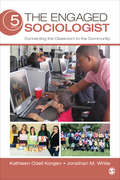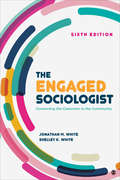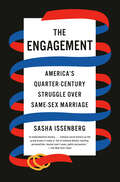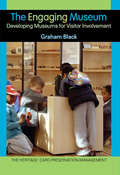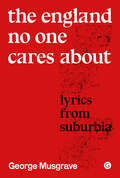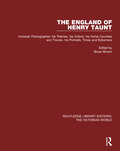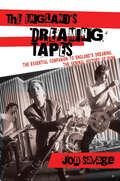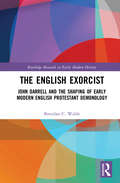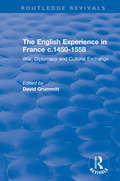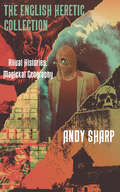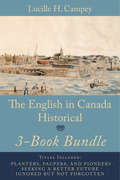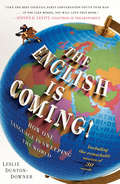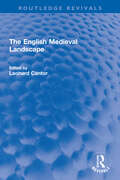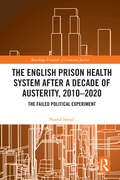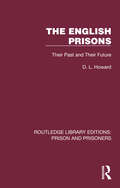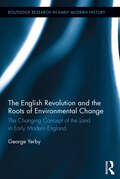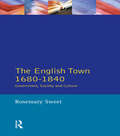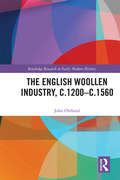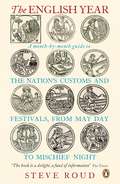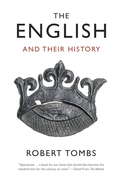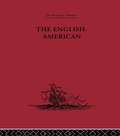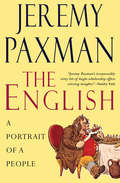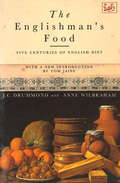- Table View
- List View
The Engaged Sociologist: Connecting the Classroom to the Community
by Kathleen Odell Korgen Jonathan M. WhiteThis fully updated edition of The Engaged Sociologist by Kathleen Odell Korgen carries the public sociology movement into the classroom, while at the same time providing an engaging overview of the entire field. It demonstrates how to think sociologically, to develop a sociological eye, and to use sociological tools to become effective participants in a democratic society. Perfect as a supplement for an introductory course, or as a main text for any course that has public sociology at its roots, this inspiring book will serve as a guidebook to any student who is passionate about applying sociological concepts to the world around them.
The Engaged Sociologist: Connecting the Classroom to the Community
by Jonathan M. White Michelle K. WhiteThis concise text for carries the public sociology movement into the introductory sociology classroom. While teaching students to think sociologically and to develop a sociological eye, it also demonstrates how sociology can be used as a tool for improving society. As they explains the discipline's basic theories and concepts, the authors provide many examples of "engaged" sociologists who are working to solve some of society's most intractable problems, and encourage students to become engaged in their own communities.
The Engaged Sociologist: Connecting the Classroom to the Community
by Jonathan M. White Michelle K. WhiteThis concise text for carries the public sociology movement into the introductory sociology classroom. While teaching students to think sociologically and to develop a sociological eye, it also demonstrates how sociology can be used as a tool for improving society. As they explains the discipline's basic theories and concepts, the authors provide many examples of "engaged" sociologists who are working to solve some of society's most intractable problems, and encourage students to become engaged in their own communities.
The Engagement: America's Quarter-Century Struggle Over Same-Sex Marriage
by Sasha IssenbergThe riveting story of the conflict over same-sex marriage in the United States—the most significant civil rights breakthrough of the new millennium. On June 26, 2015, the U.S. Supreme Court ruled that state bans on gay marriage were unconstitutional, making same-sex unions legal across the United States. But the road to that momentous decision was much longer than many know. In this definitive account, Sasha Issenberg vividly guides us through same-sex marriage’s unexpected path from the unimaginable to the inevitable. It is a story that begins in Hawaii in 1990, when a rivalry among local activists triggered a sequence of events that forced the state to justify excluding gay couples from marriage. In the White House, one president signed the Defense of Marriage Act, which elevated the matter to a national issue, and his successor tried to write it into the Constitution. Over twenty-five years, the debate played out across the country, from the first legal same-sex weddings in Massachusetts to the epic face-off over California’s Proposition 8 and, finally, to the landmark Supreme Court decisions of United States v. Windsor and Obergefell v. Hodges. From churches to hedge funds, no corner of American life went untouched. This richly detailed narrative follows the coast-to-coast conflict through courtrooms and war rooms, bedrooms and boardrooms, to shed light on every aspect of a political and legal controversy that divided Americans like no other. Following a cast of characters that includes those who sought their own right to wed, those who fought to protect the traditional definition of marriage, and those who changed their minds about it, The Engagement is certain to become a seminal book on the modern culture wars.
The Engaging Museum: Developing Museums for Visitor Involvement (The\heritage: Care - Preservation - Management Ser.)
by Graham BlackThis very practical book guides museums on how to create the highest quality experience possible for their visitors. Creating an environment that supports visitor engagement with collections means examining every stage of the visit, from the initial impetus to go to a particular institution, to front-of-house management, interpretive approach and qualitative analysis afterwards. This holistic approach will be immensely helpful to museums in meeting the needs and expectations of visitors and building their audience. This book features: includes chapter introductions and discussion sections supporting case studies to show how ideas are put into practice a lavish selection of tables, figures and plates to support and illustrate the discussion boxes showing ideas, models and planning suggestions to guide development an up-to-date bibliography of landmark research. The Engaging Museum offers a set of principles that can be adapted to any museum in any location and will be a valuable resource for institutions of every shape and size, as well as a vital addition to the reading lists of museum studies students.
The England No One Cares About: Lyrics from Suburbia (Goldsmiths Press / Sonics Series)
by George MusgraveAn exploration of the much-derided English suburbs through rap music.There are many different Englands. From the much-romanticized rolling countryside, to the cosmopolitanism of the inner cities (embraced by some as progressive, multicultural enlightenment and derided by others as the playground of a self-righteous metropolitan elite), or the disparagingly named "left behind" communities which, post-Brexit, have so interested political parties and pundits, demographers and statisticians.But there is also an England no one cares about. The England of semi-detached houses and clean driveways for multiple cars devotedly washed on Sundays, of "twitching curtains" and Laura Ashley sofas; of cul-de-sacs to nowhere and exaggerated accents; of late night drives to petrol stations on A roads, fake IDs tested in Harvesters, and faded tracksuits and over-gelled hair in Toby Carverys; of questionable hash from a "mate of a mate" and two-litre bottles of White Lightning from Budgens consumed in a kids playground. Much derided. Unglamorous, ordinary; cultural vacuity and small "c" conservatism. A hodgepodge. An—apparently—middling, middle-of-the-road middle-England of middle-class middle-mindedness. Part poetry anthology, part academic study into placemaking, and part autoethnography, The England No One Cares About innovatively brings together academic discussions of the ethnographic potential of lyrics, scholastic representations of suburbia, and thematic analysis to explore how rap music can illuminate the experiences of young men growing up in suburbia. This takes place by exploring the author&’s own annotated lyrics from his career as a musician known as Context where he was referred to by the BBC as "Middle England&’s Poet Laureate."
The England of Henry Taunt: Victorian Photographer: his Thames. his Oxford. his Home Counties and Travels. his Portraits. Times and Ephemera (Routledge Library Editions: The Victorian World #5)
by Bryan BrownHenry Taunt was one of the great photographers of the nineteenth and early twentieth centuries. He was a master of the camera and possessed of a profoundly creative sense of scene and composition. First published in 1973, this collection of Henry Taunt’s finest work includes artistic prints as well as images which are of importance to architectural and social historians. Sympathetically introduced and captioned by Bryan Brown, this book is a striking visual essay on the Victorian and Edwardian eras and a magnificent record of places and their past.
The England's Dreaming Tapes
by Jon SavageJon Savage's 1991 book, England's Dreaming: Anarchy, Sex Pistols, Punk Rock, and Beyond, was hailed by the New York Times Book Review as "the definitive history of the English punk movement." Widely imitated but never equaled, it remains that rare work of music history that appeals to music fans, critics, and scholars alike. In researching England's Dreaming, Savage conducted hundreds of hours of interviews of which only a fraction made it into the finished book. Now, in The England's Dreaming Tapes, Savage makes available for the first time the full, uncut, sensational story behind the cultural moment that was punk.Here is the story of a generation that changed the world in just a few months in 1976, as told by the scene's major figures: all four original Sex Pistols as well as Joe Strummer, Chrissie Hynde, Jordan, Siouxsie Sioux, Viv Albertine, Adam Ant, Lee Black Childers, Howard Devoto, Pete Shelley, Syl Sylvain, Debbie Wilson, Tony Wilson, Jah Wobble, and many others. Together, they offer a sweeping history of the late 1960s and the 1970s-not just the era's music, but also its radical politics, social issues, fashion, and culture.An invaluable source of information about a movement that has become obscured by myth, these vivid, unvarnished interviews were conducted when punk was only a decade old. In many cases, this was the first time that the subjects had talked about the period. The interviews describe the founding of the Sex Pistols; 430 King's Road, site of the legendary boutique Sex, which helped establish the punk aesthetic; punk rock New York; the cultural landscapes of London and its suburbs; the writers who covered punk; and the Manchester music scene centered around Factory Records.With The England's Dreaming Tapes, Savage gives us the first and final word on the music, fashion, and attitude that defined this influential and incendiary era.
The English Exorcist: John Darrell and the Shaping of Early Modern English Protestant Demonology
by Brendan C. WalshIn 1598, the English clergyman John Darrell was brought before the High Commission at Lambeth Palace to face charges of fraud and counterfeiting. The ecclesiastical authorities alleged that he had "taught 4. to counterfeite" demonic possession over a ten-year period, fashioning himself into a miracle worker. Coming to the attention of the public through his dramatic and successful role as an exorcist in the late sixteenth century, Darrell became a symbol of Puritan spirituality and the subject of fierce ecclesiastical persecution. The High Commission of John Darrell became a flashpoint for theological and demonological debate, functioning as a catalyst for spiritual reform in the early seventeenth-century English Church. John Darrell has long been maligned by scholars; a historiographical perception that this book challenges. The English Exorcist is the first study to provide an in-depth scholarly treatment of Darrell’s exorcism ministry and his demonology. It shines new light on the corpus of theological treatises that emerged from the Darrell Controversy, thereby illustrating the profound impact of Darrell’s exorcism ministry on early modern Reformed English Protestant demonology. The book establishes an intellectual biography of this figure and sketches out the full compelling story of the Darrell Controversy.
The English Experience in France c.1450-1558: War, Diplomacy and Cultural Exchange (Routledge Revivals)
by David GrummittThis title was first published in 2002: This collection of essays is based on papers delivered at a conference held at the Public Record Office in November 1999. The purpose of the book is to highlight the close links between England and France and the role of England and Englishmen in Renaissance Europe. It provides a statement of current research by the leading scholars in that field and should serve as a basis both for teaching and for further work. It is necessary to fill the gap that exists in the history of this period, which is currently concentrated in narrative, diplomatic history or general surveys of the role of England in Europe. This coherent set of essays, built around complementary themes, and with the addition of a historiographical and thematic introduction, focuses solely on England and France in the period after the end of the Hundred Years War and before the onset of French Wars of Religion.
The English Heretic Collection: Ritual Histories, Magickal Geography
by Andy SharpFrom its inaugural Black Plaque in honour of Witchfinder General director Michael Reeves, this unique collection follows a veridical trajectory to the frontiers of belief. Reeves' film becomes a conspiratorial cauldron drawing in a host of tragic players in the end game of the Sixties. The Cornwall of Du Maurier's The Birds is ploughed to reveal the hidden psychic codes of our Blitz spirit. In a powerfully relevant occult rendering of a bruised Island, the myth of Churchill is dissected and re-animalised. New maps of hell are drawn by colliding the forensic vision of JG Ballard and Lovecraftian magic. Actors, witches and psychopaths maraud across a nightmare terrain of murderous henges and abandoned military bases; conflating creative research into a surreal documentary, history as hallucination. Geography becomes an alchemical alembic, a vale of soul-making distilled by the lysergic psychobiology of Stanislav Grof, the alcoholic lyricism of Malcolm Lowry, and the convulsive travelogues of the Marquis de Sade. If history is revealed as paranoid ritual, how do we escape its time traps to wild new imaginative geographies? The English Heretic collection is a darkly comical, urgently lyrical, mental escape hatch from the hells of our own making.
The English In Canada Historical 3-Book Bundle: Planters, Paupers, and Pioneers / Seeking a Better Future / Ignored but not Forgotten
by Lucille H. CampeyLucille H. Campey’s acclaimed, groundbreaking series on English immigration to Canada is finally available in a collected volume with this complete, three-book edition. A must for genealogists and history lovers interested in the tremendous waves of English immigration to Canada, whose story has never been told in its full depth and detail until now. Planters, Paupers, and Pioneers: English Settlers in Atlantic Canada The first-ever comprehensive book written on early English immigration to Canada, Planters, Paupers, and Pioneers focuses on the factors that brought the English to Atlantic Canada. It traces English arrivals to their various settlements in Nova Scotia, New Brunswick, Prince Edward Island, and Newfoundland, and considers their reasons for leaving their homeland. Who were they? When did they arrive? Were they successful? And what was their lasting impact? Drawing on wide-raging documentary resources, this book is essential reading for individuals wishing to trace English and Canadian family links. Seeking a Better Future: The English Pioneers of Ontario and Quebec The exodus from England that gathered pace during the 19th century accounted for the greatest part of the total emigration from Britain to Canada. And yet, while copious emigration studies have been undertaken on the Scots and the Irish, very little has been written about the English in Canada. Drawing on wide-ranging data collected from English record offices and Canadian archives, Seeking a Better Future considers why people left England and traces their destinations in Ontario and Quebec. Challenging the widely held assumption that emigration was primarily a flight from poverty, Campey reveals how the ambitious and resourceful English were strongly attracted by the greater freedoms and better livelihoods that could be achieved by relocating to Canada’s central provinces. Ignored but not Forgotten: Canada’s English Immigrants The great exodus from England to Canada peaked in the early 20th century, and although they were widely ignored in the past as an immigrant group, the English are now being given the attention they deserve. Drawing on wide-ranging documentary and statistical sources, Ignored but not Forgotten traces this major population movement on a region-by-region basis. Campey reveals the outstanding contributions by English immigrants to Canada’s settlement and development, and challenges the assumption that English Canadians were a privileged elite. In fact, most came from humble backgrounds. The book is essential reading for genealogists and general readers interested in why the English immigrated to Canada and the great scope of their achievements. What critics are saying "Campey’s chapters are well-written and hold the readers attention." — GenealogyMagazine.com "A major addition to the literature for those looking for insight into their pioneer immigrant ancestor experience." — Anglo-Celtic Connections "[Lucille Campey] has distilled a copious amount of research.… informative and engaging." — The British Columbia Genealogist
The English Is Coming!
by Leslie Dunton-DownerEnglish has fast become the number one language for everything from business and science, diplomacy and education, entertainment and environmentalism to socializing and beyond--virtually any human activity unfolding on a global scale. Worldwide, nonnative speakers of English now outnumber natives three to one; and in China alone, more people use English than in the United States--a remarkable feat for a language that got its start as a mongrel tongue on an island fifteen hundred years ago.Through the fascinating stories of thirty English words used and understood in nearly all corners of the globe, The English Is Coming! takes readers on an eye-opening journey across culture and commerce, war and peace, and time and space. These mini-histories shed new light on everyday words: the strange turns of fate by which their meanings evolved and their new roles as the building blocks of the first language ever to forge a global community. Exploring such familiar terms as shampoo (from a Hindi word for scalp and body hygiene long practiced in India); robot (coined by Czech painter Josef Capek for his brother Karel's 1921 play about man-made creatures); credit (rooted in a prehistoric phrase of sacred significance: "to put heart into"); and dozens of others, Dunton-Downer reveals with clarity and humor how these linguistic artifacts embody the resilience, appeal, adoptability, and wild inclusiveness that English, through a series of historical accidents, gained on its road to worldwide reach. These words explain not only how English has managed to link our distant and often disparate pasts but also how it is propelling humankind to a future that we can, for the first time, talk about and shape in a language that now belongs to all of us: Global English. Perfect for culture buffs, armchair travelers, and language lovers alike, The English Is Coming! is sure to inspire truly global conversations for decades to come.
The English Medieval Landscape (Routledge Revivals)
by Leonard CantorFirst published in 1982, The English Medieval Landscape was written to recreate and analyse the development of the major elements of the medieval landscape. Illustrated with maps and photographs, the book explores the nature of the English landscape between 1066 and 1485, from farms and chases to castles, monastic settlements, villages, roads, and more. The English Medieval Landscape will appeal to those with an interest in medieval history and British social history.
The English Prison Health System After a Decade of Austerity, 2010-2020: The Failed Political Experiment (Routledge Frontiers of Criminal Justice)
by Nasrul IsmailAusterity has reconfigured and scaled back the governance and delivery of public services and negatively affected society’s most vulnerable groups. This book opens up the closed world of English prisons to examine its impact on prison health governance and healthcare delivery. It argues that austerity has been a decade-long, large-scale political experiment that has caused debt to balloon, eroded the prison health system and perpetuated a cycle of punishment resulting in sicker prisoners. In short, austerity has violated prisoners’ human rights. Drawing on interviews and data from existing longitudinal and economic analyses, the book demonstrates how austerity has resulted in high rates of recidivism, diminished what remains of the welfare state, and increased inequality and punitiveness. Despite a decade of failure, there is a marked political reluctance to dispense with austerity, and the governmental juggernaut continues to produce the same result. As the spectre of recession increases, caused in part by Brexit and COVID-19, these failures are ever more perilous. This book blends the interdisciplinary perspectives of criminology, public health, sociology, law, social policy, politics, and economics to enable greater understanding of the impact of austerity on health governance, prison healthcare, the prison workforce, and prisoners’ health and safety. It challenges current policy, practice and thinking, and is a must read for anyone who wants to reflect on how the political economic structure can affect the governance and delivery of healthcare services in marginalised settings, beyond prisons, and indeed beyond England.
The English Prisons: Their Past and Their Future (Routledge Library Editions: Prison and Prisoners)
by D. L. HowardIn the late 1950s crime and its treatment had never been of greater public interest. In The English Prisons, originally published in 1960, D.L. Howard used his knowledge of academic criminology and his practical experience of criminals of all ages to produce a book which would be of value to all who were concerned with crime in this country at the time. The author gives the first full survey of the history of prisons to appear for many years. He describes conditions in the early prisons and prison hulks, the colonial penal settlements, and the part played by outstanding individuals such as John Howard, Elizabeth Fry and Alexander Paterson in the development of the modern prison system. He then discusses, in the light of first-class experience as a trained sociologist working inside an English prison, the changes which were taking place in the treatment of criminals, and the problems which these changes were creating. Mr Howard shows a rare insight into his subject, and this, together with an ability to write vividly and informally, would make his book appeal to both the general reader and all who were studying the social sciences in the universities and as part of their training for social work. Today it can be read in its historical context.
The English Revolution and the Roots of Environmental Change: The Changing Concept of the Land in Early Modern England
by George YerbyThis study brings a new perspective to a pivotal debate: the causes of the English Revolution. It pinpoints the economic motives behind the opposition to the crown, and shows their connection to the changing mind-set and political transitions of the time. Distinctively, it identifies the radicalism of the mercantile sphere, and the developing claim of "freedom of trade," the basis on which parliament challenged the king’s fiscal prerogative. Freedom of trade was associated with rights of consent, which were asserted as a guarantee of economic interests, and as a political principle. This informed the constitutional changes pushed through by parliament early in 1641, establishing freedom of trade by parliamentary control of the customs, and giving the assembly an automatic place at the center of affairs, the first requirement of representative government. Crucially, it was not the crown but parliament that appropriated the state interest, through an independent definition of national priorities. As England coalesced into a political and commercial unit, the open and communal patterns of medieval times were overlaid. The land itself came to be perceived and used in a different way. Freedom of trade had an agrarian aspect. An extended class of gentry and yeomanry occupied consolidated farms, displacing the smallholders from the common lands. With intensified marketing, the old moral restraints on trade and property died away. A more exploitative ethic undermined the balance of relationship with the land. The book makes an original connection between the English Revolution and the processes of environmental change.
The English Town, 1680-1840: Government, Society and Culture (Themes In British Social History)
by Rosemary SweetAn impressively thorough exploration of the changing functions, character and experience of English towns in a key age of transition which includes smaller communities as well as the larger industrialising towns. Among the issues examined are demography, social stratification, manners, religion, gender, dissent, amenities and entertainment, and the resilience of provincial culture in the face of the growing influence of London. At its heart is an authoritative study of urban politics: the structures of authority, the realities of civic administration, and the general movement for reform that climaxed in the Municipal Corporations Act of 1835.
The English Woollen Industry, c.1200-c.1560
by John OldlandThis is the first book to describe the early English woollens’ industry and its dominance of the trade in quality cloth across Europe by the mid-sixteenth century, as English trade was transformed from dependence on wool to value-added woollen cloth. It compares English and continental draperies, weighs the advantages of urban and rural production, and examines both quality and coarse cloths. Rural clothiers who made broadcloth to a consistent high quality at relatively low cost, Merchant Adventurers who enjoyed a trade monopoly with the Low Countries, and Antwerp’s artisans who finished cloth to customers’ needs all eventually combined to make English woollens unbeatable on the continent.
The English Year: A Month-by-month Guide To The Nation's Customs And Festivals, From May Day To Mischief Night
by Steve RoudThis enthralling book will take you, month-by-month, day-by-day, through all the festivities of English life. From national celebrations such as New Year’s Eve to regional customs such as the Padstow Hobby Horse procession, cheese rolling in Gloucestershire and Easter Monday bottle kicking in Leeds, it explains how they originated, what they mean and when they occur.A fascinating guide to the richness of our heritage and the sometimes eccentric nature of life in England, The English Year offers a unique chronological view of our social customs and attitudes
The English and Their History
by Robert TombsRobert Tombs's momentous The English and Their History is both a startlingly fresh and a uniquely inclusive account of the people who have a claim to be the oldest nation in the world. The English first came into existence as an idea, before they had a common ruler and before the country they lived in even had a name. They have lasted as a recognizable entity ever since, and their defining national institutions can be traced back to the earliest years of their history.The English have come a long way from those first precarious days of invasion and conquest, with many spectacular changes of fortune. Their political, economic and cultural contacts have left traces for good and ill across the world. This book describes their history and its meanings from their beginnings in the monasteries of Northumbria and the wetlands of Wessex to the cosmopolitan energy of today's England. Robert Tombs draws out important threads running through the story, including participatory government, language, law, religion, the land and the sea, and ever-changing relations with other peoples. Not the least of these connections are the ways the English have understood their own history, have argued about it, forgotten it and yet been shaped by it. These diverse and sometimes conflicting understandings are an inherent part of their identity.Rather to their surprise, as ties within the United Kingdom loosen, the English are suddenly embarking on a new chapter. The English and Their History, the first single-volume work on this scale for more than half a century, and which incorporates a wealth of recent scholarship, presents a challenging modern account of this immense and continuing story, bringing out the strength and resilience of English government, the deep patterns of division and also the persistent capacity to come together in the face of danger.From the Hardcover edition.
The English and Their History
by Robert TombsA New York Times 2016 Notable BookRobert Tombs's momentous The English and Their History is both a startlingly fresh and a uniquely inclusive account of the people who have a claim to be the oldest nation in the world. The English first came into existence as an idea, before they had a common ruler and before the country they lived in even had a name. They have lasted as a recognizable entity ever since, and their defining national institutions can be traced back to the earliest years of their history.The English have come a long way from those first precarious days of invasion and conquest, with many spectacular changes of fortune. Their political, economic and cultural contacts have left traces for good and ill across the world. This book describes their history and its meanings from their beginnings in the monasteries of Northumbria and the wetlands of Wessex to the cosmopolitan energy of today's England. Robert Tombs draws out important threads running through the story, including participatory government, language, law, religion, the land and the sea, and ever-changing relations with other peoples. Not the least of these connections are the ways the English have understood their own history, have argued about it, forgotten it and yet been shaped by it. These diverse and sometimes conflicting understandings are an inherent part of their identity.Rather to their surprise, as ties within the United Kingdom loosen, the English are suddenly embarking on a new chapter. The English and Their History, the first single-volume work on this scale for more than half a century, and which incorporates a wealth of recent scholarship, presents a challenging modern account of this immense and continuing story, bringing out the strength and resilience of English government, the deep patterns of division and also the persistent capacity to come together in the face of danger.
The English-American: A New Survey of the West Indies, 1648 (Routledge Revivals Ser.)
by Thomas GageFirst published in 1928.'Can be safely named unique and can never quite lose its value.' Times Literary Supplement. 'This should be bought not borrowed.' Saturday Review The publication in 1648 of the first authentic account of the provinces of New Spain and Central America by a well-known and educated Englishman excited widespread interest, and The English-American found many readers even though the country was in the midst of revolution. It played an important part in reviving the anti-Spanish policy of Elizabeth and describes at first hand a stage of American society that was virtually unknown.A. P. Newton's introduction places the book against the background of its time, which is vital in order to understand many of Thomas Gage's allusions. Although abridged from the original, the full chapter headings of the First Edition and the original numbering have been preserved.
The English: A Portrait of a People
by Jeremy PaxmanThe acclaimed author of On Royalty explores the mysteries of English identity in this &“witty, argumentative book bursting with good things&” (The Daily Telegraph). A Sunday Times Top Ten Bestseller Being English used to be easy. As the dominant culture in a country that dominated an empire that dominated the world, they had little need to examine themselves and ask who they were. But something has happened over the past century. A new self-confidence seems to have taken hold in Wales and Scotland, while others try to forge a new relationship with Europe. What exactly sets the English apart from their British compatriots? Is there such a thing as an English race? Renowned journalist and bestselling author Jeremy Paxman traces the invention of Englishness to its current crisis and concludes that, for all their characteristic gloom about themselves, the English may have developed a form of nationalism for the twenty-first century. &“Paxman&’s irrepressibly witty bit of Anglo scholarship offers stirring insights.&” —Vanity Fair
The Englishman's Food: Five Centuries of English Diet
by Anne Wilbraham J.C. DrummondMedieval gardens; cookshops; spices; ale, beer, wine and spirits; the food of peasants, labourers, townspeople, the wealthy, the poor and the country gentleman; fish, meat and game; the feeding of infants, children; dairy products; vitamins, proteins, fat and fibre; the adulteration of food; the four bottle man; bread; poaching; tea, coffee and chocolate; food in schools and institutions; sugar and sweetmeats; root crops; the agricultural revolution; the importance of 'white meats', the vegetarian diet; menus and recipes. . .The Englishman's Food was first published in 1939, fully revised in 1957 and now appears with a new updating introduction. A ground-breaking book, it is a fascinating and authoritative survey of food production, consumption, fashions and follies over a period of five hundred years. Reprinted with a new introduction by food editor Tom Jaine.
